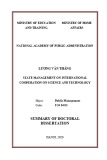
31
HNUE JOURNAL OF SCIENCE
Social Sciences 2024, Volume 69, Issue 4, pp. 31-44
This paper is available online at https://hnuejs.edu.vn/
DOI: 10.18173/2354-1067.2024-0065
ADVANCING EDUCATION IN THE WAR CONTEXT: THE COOPERATION
OF THE REPUBLIC OF VIETNAM AND THE ASIA FOUNDATION
IN THE YEARS 1956-1975
Truong Thuy Dung1 and Ninh Xuan Thao*2
1Institute of History, Vietnam Academy of Social Sciences, Hanoi city, Vietnam
2Faculty of History, Hanoi National University of Education, Hanoi city, Vietnam
*Corresponding author: Ninh Xuan Thao; email: thaonx@hnue.edu.vn
Received October 4, 2024. Revised October 28, 2024. Accepted November 5, 2024.
Abstract. The prolonged conflicts from the liberation movements to the resistance wars in
Vietnam in the twentieth century, primarily against the French and American imperialists,
shaped contemporary interests in the military struggle rather than cultural, educational, and
other social issues. This subsequently affected research tendencies in Vietnamese and foreign
scholars' post-war works, which mainly focused on hostilities. However, Vietnamese
society's dynamics and mobilization could not be explained and understood without
comprehensive knowledge of other aspects beyond the military. Among all the aspects
developed in South Vietnam during the war, the Republic of Vietnam's education made an
impression through its unique achievements. By pointing out the premises for building an
educational cooperative relationship between the Asia Foundation and the Republic of
Vietnam in the years 1956-1975; analyzing critical cooperative activities of the Asia
Foundation in South Vietnam in the field of education, which included budget and programs,
university personnel, and educational materials; and drawing out the features of educational
collaboration in South Vietnam during the war, this study aims to gain insight into the
development of the Republic of Vietnam's education, to understand the mutual effects of
politics, society, military and education; the distinct essence of education that grew in the
war context; and the lingering legacies from the educational collaboration between the Asia
Foundation and the Republic of Vietnam education.
Keywords: The Asia Foundation, Republic of Vietnam, South Vietnam, education,
international cooperation.
1. Introduction
Situated in a special geographical location in Southeast Asia, Vietnam attracted the
attention of most powers in the twentieth century, from England, France, the United States, and
the Soviet Union to China. She was a 'hotspot' in the influence competition of great powers in
the context of the Cold War. It is assumed that Vietnam was one of the critical elements in
understanding and explaining the dynamics and evolution of international relations during this
period. The war in Vietnam was one of the US longest wars of the twentieth century [1], and
the dynamics of this war were also so unique that it is impossible to gain insight into it just by
casualty figures, the volume of weapons, and the war expenses, but also other countless tangible
and intangible impacts, one of which is the development and movement of non-military issues
in the context of war.













